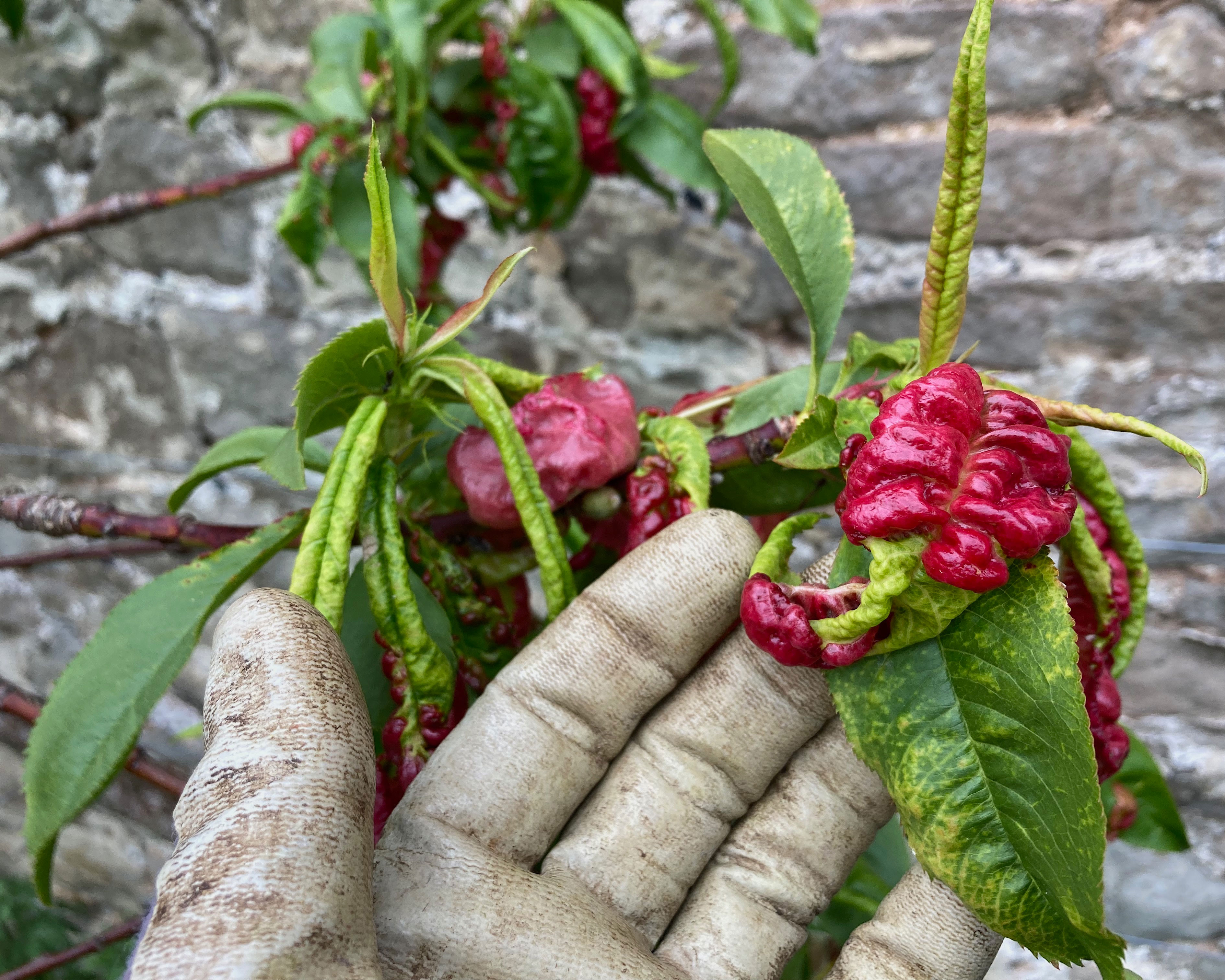How to prune a peach tree – essential steps for pruning and maintaining all forms of peaches
Discover how to prune a peach tree to boost fruit crops and keep your tree healthy


You need to know how to prune a peach tree to maximize crop production of the delicious fruits. The thought of picking juicy fresh fruit straight from the garden needn’t be a fantasy, as with a little intervention this dream could become a reality.
Peach trees, Prunus persica, are self-fertile and can be planted as part of a backyard orchard, trained as fan, espalier or step over fruit trees, or dwarf specimens are ideal for pots. It's easy to learn how to grow peach trees, and these natives to China thrive in full sun and slightly acidic soil.
Whether you are growing freestone or clingstone peaches you will want to get the most out of your peach tree, so maintenance of the plant is key to success.
How to prune a peach tree – top tips
Peach are among the best fruit trees to grow but knowing how to prune peach trees is an essential part of maintaining fruit tree vitality. If left unpruned, the trees soon become a tangled mass of growth, blocking out light to branches and stifling air flow.
'With all fruit tree pruning it is good to understand how the tree is growing. Consider the tree’s health, vigor and productivity when making decisions on how and where to prune your tree,' says Andy Lewis, specialist fruit grower at The Newt.
Create an open framework for fruit production by removing shoots growing into the center of the peach tree and keep the height of your tree low enough for you to hand harvest.
‘A tree will always try to be a tree and grow towards the sky. It is your job to balance the tree using rejuvenative pruning, keeping fruit within reasonable picking height and also allowing for good light and air circulation,’ advises Andy Lewis.
Step-by-step peach tree pruning guide

The reason you need to know how to prune peach trees is because ‘pruning is all about helping a tree use the energy it gets from the sun and soil in the most efficient way,' says Cassidy Villeneuve of organic, regenerative Frog Hollow Farm, in Northern California.
‘The goal is to grow a few big, healthy, sweet fruits – rather than lots of small, not-so-tasty fruits – and to keep the tree healthy for years to come,’ she adds.
These few essential steps will help simplify how to prune a peach tree:
- ‘Make way for new growth by removing dead branches. “Dead wood” takes energy from the tree that could be going to the thriving branches instead,’ says Villeneuve.
- ‘Let sunshine in. Leaves are like little solar panels that power the sugar development in each fruit. If light can’t reach those bottom branches, the fruit won’t develop enough sugar,’ she adds.
- 'Get air flowing around the tree, which deters disease. Rust fungus and brown rot spores love a moist, dark environment. We don’t love them.'
- Also remove rootstock suckers at the base; these do nothing but drain the tree’s energy.
Peach trees are among the best fast growing fruit trees. They fruit on second-year wood, so prune back last season’s growth by around a half to an outward facing bud; this will concentrate energy into producing fruiting buds.
Make an angled cut just above a bud – the node – this will ensure water drips away from the bud and does not sit in the prune wound.
The tools needed to prune a peach tree

Sharp blades and clean cuts are important when learning how to prune a peach tree, so that pruning does not leave the tree vulnerable to fungal diseases entering wounds via damaged branches.
‘Having a professional secateur – or hand pruner – with quality steel, which does not rust, is a must have for any professional or aspiring gardener,’ says Tom Wade of Sorbus International, specialists in premium Japanese pruning tools.
Whippy new growth can be cut back with a pair of bypass secateurs, but for larger branches a pair of loppers or even a hand saw may be necessary.
‘Pruning fruit trees such as Prunus persica can require different tools for different stages of maturity. Having a lightweight telescopic pruner can save hours of time and effort reaching different areas of the canopy,' adds Tom Wade.
For those hard to reach branches a long arm pruner will ensure you get the job done without reaching for a ladder; this also easily allows you to step back and check the shape of your tree as you prune.
‘Look after your tools and they will look after you. Japanese steel has been widely regarded as the pinnacle for producing cutting blades that keep their edge. Find a tool that lets you work freely with minimal fatigue,’ Wade adds.
It is also a good idea to wear eye protection to prevent injury as well as wearing a good pair of gardening gloves.
How to prune young peach trees

Pruning is important to maintain the desired shape of your peach tree. ‘How you prune a one-year-old tree will determine the shape it has for the rest of its life,' explains Cassidy Villeneuve.
In the peach trees' early years, it is important to control pruning with clean cuts and minimalistic reductions. 'This is where having a sharp edge can be most useful,’ explains Tom Wade. ‘Be careful your secateurs, or hand pruners, are cutting the stem rather than tearing, and the blades are shiny and clean for ease of use.’
Pruning is an art form and to a certain extent you are sculpting the tree to meet the needs of the space you are growing it in. For orchard trees a vase shape is optimal.
‘You need to know how a tree behaves, how it wants to grow, what it needs to thrive, and how to prepare it for how you want to harvest. The Frog Hollow team can’t let a tree grow too tall, for example, or ladders wouldn’t be able to reach the highest fruit,’ explains Cassidy Villeneuve.
How to train a peach tree
Peach trees grow well trained as fan or espalier. They can enhance a bare, south-facing wall, or be grown as part of your vegetable garden trellis ideas.
Fan shaped trees are grown against a sunny wall and have multiple branches growing from the base, whereas espalier trained trees have a vertical trunk and then a series of horizontal tiers extending along supports. Branches here are kept short to maximize fruit production in a small space.
‘I would always suggest growing peach trees against a wall,’ advises Andy Lewis from The Newt. ‘The wall will help to retain heat, ripening both fruit and buds. With the close proximity of a wall, you can utilise the structure to keep rain drops off and reduce the risk of peach leaf curl.’
Alternatively, train peach trees as step-overs; a fun way to grow fruit in your garden when you may not have space for a fully grown tree. Step-overs are ideal for small vegetable garden ideas and are grown in a ’T’ shape, which can literally be stepped over – hence the name.
It is especially important to know how to prune a peach tree trained in this manner as strict pruning is required to keep them under control.

How do you maintain a peach tree?
You can best maintain a peach tree by using clean, sharp tools for pruning and by knowing when to prune a peach tree, so you always cut it at the correct time.
Disinfect tools between pruning different plants to minimize the risk of spreading diseases.
‘You can never underestimate the importance of having a cutting tool with a razor edge blade that is durable and keeps for years on end,' stresses Tom Wade.
Peach trees are susceptible to peach leaf curl, Taphrina deformans, a fungal disease causing distorted leaves in spring. Optimal leaf curl conditions are rain and temperatures between 47°F (8°C) and 61°F (16°C). It is quite common to see thick, often red crinkly leaves covered in colored warts; the affected leaves quickly defoliate.
If your peach tree is under attack then prune out the worst affected stems and remove all diseased leaves from the tree, including any fallen on the ground to break the diseases life cycle. Avoid pruning on wet days. Do not compost waste material.
Silver leaf, Chondrostereum purpureum, is a fungal disease that affects the wood of stoned fruit trees, causing branches to die back and leaves to appear silver as the top and bottom layer of leaves separate reacting to the infection. Silver leaf is transferred by pruning. Air borne spores are active in fall and winter, so avoid pruning at these times.
Sign up to the Homes & Gardens newsletter
Design expertise in your inbox – from inspiring decorating ideas and beautiful celebrity homes to practical gardening advice and shopping round-ups.

Debi Holland runs her own garden business in the south of west of England, gardening in beautiful country homes, and also writes for numerous online and print publications and presents online talks advocating ‘Gardening for Wellbeing.’
-
 Grace Kelly's former living room set the blueprint for quiet luxury – you can explore her NYC penthouse (listed for $3.25 million)
Grace Kelly's former living room set the blueprint for quiet luxury – you can explore her NYC penthouse (listed for $3.25 million)A unit in the storied Manhattan House, where Grace Kelly, Benny Goodman, and Shirley Jackson have lived, has hit the market – it's a masterclass in neutrals
By Hannah Ziegler Published
-
 I'm 5ft2 and this telescopic scrubber safely and easily banished mold and grime in even the hardest-to-reach areas of my bathroom in less than 15 minutes
I'm 5ft2 and this telescopic scrubber safely and easily banished mold and grime in even the hardest-to-reach areas of my bathroom in less than 15 minutesMy bathroom has never looked better thanks to this handy $16 two-in-one tool from Joseph Joseph
By Ottilie Blackhall Published